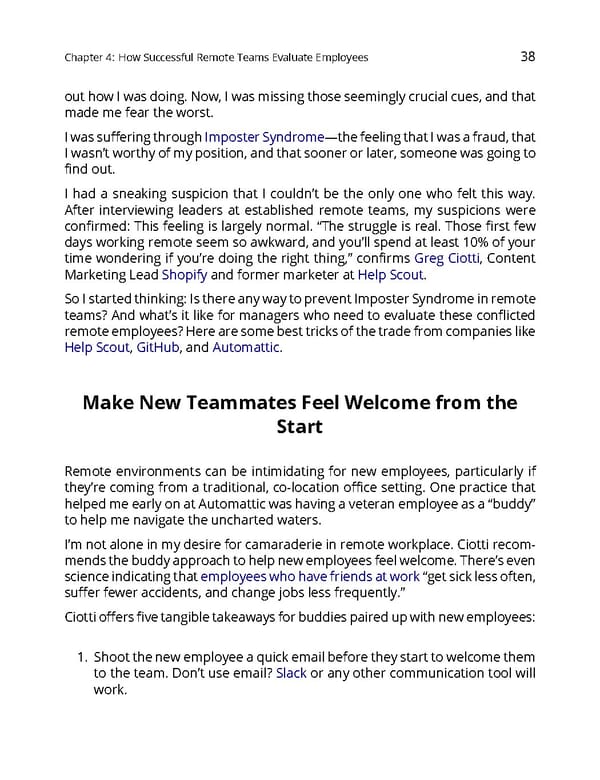Chapter4: HowSuccessfulRemoteTeamsEvaluateEmployees 38 outhowIwasdoing.Now,Iwasmissingthoseseeminglycrucialcues,andthat mademefeartheworst. I wassufferingthroughImposterSyndrome—thefeelingthatIwasafraud,that I wasn’t worthy of myposition,andthatsoonerorlater,someonewasgoingto find out. I had a sneaking suspicion that I couldn’t be the only one who felt this way. After interviewing leaders at established remote teams, my suspicions were confirmed: This feeling is largely normal. “The struggle is real. Those first few days working remote seem so awkward, and you’ll spend at least 10% of your time wondering if you’re doing the right thing,” confirms Greg Ciotti, Content MarketingLeadShopifyandformermarketeratHelpScout. SoIstartedthinking:IsthereanywaytopreventImposterSyndromeinremote teams? And what’s it like for managers who need to evaluate these conflicted remoteemployees?Herearesomebesttricksofthetradefromcompanieslike HelpScout,GitHub,andAutomattic. MakeNewTeammatesFeelWelcomefromthe Start Remote environments can be intimidating for new employees, particularly if they’re coming from a traditional, co-location office setting. One practice that helpedmeearlyonatAutomatticwashavingaveteranemployeeasa“buddy” to help me navigate the uncharted waters. I’m not alone in my desire for camaraderie in remote workplace. Ciotti recom- mendsthebuddyapproachtohelpnewemployeesfeelwelcome.There’seven scienceindicatingthatemployeeswhohavefriendsatwork“getsicklessoften, suffer fewer accidents, and change jobs less frequently.” Ciottioffersfivetangibletakeawaysforbuddiespairedupwithnewemployees: 1. Shootthenewemployeeaquickemailbeforetheystarttowelcomethem to the team. Don’t use email? Slack or any other communication tool will work.
 The Ultimate Guide to Remote Work Page 41 Page 43
The Ultimate Guide to Remote Work Page 41 Page 43